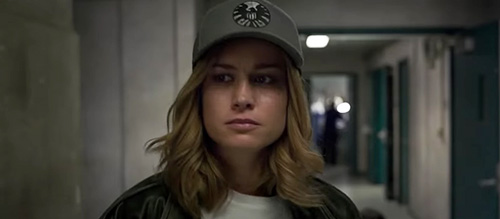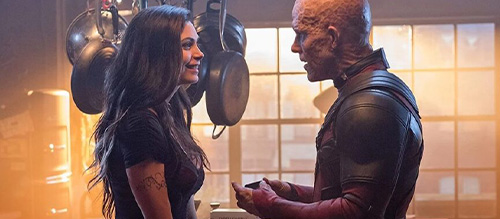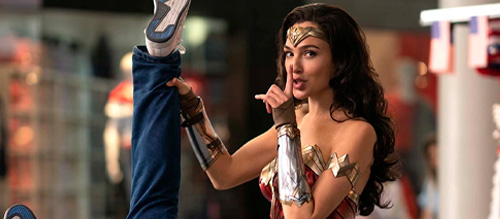Straightwashing Removes All Rainbows: Removing Bisexuals from Comic Book Films
“We take the subject of representation very seriously” decries any big tent-pole director digging up their latest excursion into blockbusting cinema, promising representation for the LGBTQ+ society – an “exclusively gay moment” here, a “tip of the hat” there. What they amount to, often, is a character holding the hand of someone of the same gender. Or, if they really want to push the boat out, a secondary character making a vague allusion to liking other things. This seems to be enough for the filmmakers to pat themselves on the back without the neck-ache of having to cut around stuff for the ever-lucrative international market.
That’s fine, generally, when the movie is an original piece or a sequel to a long-beloved franchise – Jungle Cruise and Star Wars: The Rise of Skywalker spring to mind – but in an age in which the superhero reigns supreme in all multiplex cinemas, where Marvel stands tall among your options and DC offer more films, the blockbuster sphere’s choices in representation must face more scrutiny. Both Marvel and DC should be praised for an often interesting route of colour-blind casting, shifting the films away from a sea of white faces like their comic book counterparts, but when it comes to sexuality the cinematic multiverses of both comic book companies have been let down.

Things change in adaptations – outfits are modified, origins tweaked, sometimes even superpowers are added or subtracted – but characters’ sexualities are often so intensely a part of who they are that taking them away is undoubtedly detrimental to their representation. What would Spider-Man be without his pining for MJ or Gwen? What would Batman be without his flirtations with Catwoman? The comic books they’re based on are filled with gay, lesbian, bisexual and transgender characters. But, while generally gay, lesbian or trans characters have just been flat out avoided, bisexual characters have been straight-washed into oblivion.
From the start of the modern era of comic book movies, canonically bisexual characters have been dumped into the wasteland of being depicted as straight. The “X-Men” comics, for example, have always been political stories – Stan Lee based Professor Xavier and Magneto on Martin Luther King and Malcolm X – but under the tenure of Chris Claremont, the stories dovetailed into addressing the oppression he saw en masse: that faced by the LGBTQ+ community.
Claremont wrote in the 80s, during the AIDS crisis, and his stories followed similar routes. Rogue is one of the central heroes of the original X-Men trilogy, and yet for the three films she is only ever presented as straight. Much was made about how Ian McKellen suggested certain scenes in X2 allude to “coming out”, and yet the sexualities of the canon characters remained ignored. This is even more interesting given that Rogue actress Anna Paquin is bisexual, and the director of X-Men and X2, Bryan Singer, is also bisexual, yet Rogue is reduced to someone pining for a boy. Notoriously homophobic director Brett Ratner, brought in to helm the third film, even forces a pointless love triangle for her, Rogue being pined after by both Ice-Man and Shadowcat.

What becomes more perplexing is that the prequel quadrilogy – X-Men: First Class, X-Men: Days of Future Past, X-Men: Apocalypse and Dark Phoenix – pivots to focusing on the young iteration of Mystique. In the original films, Rebecca Romijn’s interpretation is a loyal, and lethal, second-in-command to Magneto until she is turned “normal” by the mutant cure. But in the prequels Jennifer Lawrence is given a much more substantial role, eventually becoming the focus of the second film. Yet, despite the prequels being even more overt in their allusion to LGBTQ+ issues (Mystique’s final line in First Class is “mutant and proud”), she is depicted as straight, First Class presenting her burgeoning romance with Nicholas Hoult’s Beast and her growing interest in Michael Fassbender’s Magneto.
Despite going off on her own for the subsequent two films, there is nothing made of her sexuality. She is depicted as straight despite Mystique’s status as a bisexual woman. What makes this worse is that there is plenty to mine in terms of representation. Mystique’s list of powers includes shapeshifting. This provides ample chance to explore the concept of passing for straight. Had they used her sexuality properly, this could have been a way to look at how people sexually express themselves – her blue form representing her interest in men and women, her “normal” form being a way of conforming to the sexuality binary of gay or straight.
Bryan Singer also directed Days of Future Past and Apocalypse, thus making his four X-Men films notable for being so lacking in representing their characters properly. In Apocalypse, for example, Olivia Munn’s Psylocke is reduced to a near-mute henchman of villain Apocalypse (Oscar Isaac). Munn is given nothing to do. In fact, she has the least of the four Horseman that follow Apocalypse, and by the end is the only one not to die (ArkAngel) or defect (Storm, Magneto). She skulks off into the shadows never to be referenced again.
The argument could be made that these are films aimed at children and a large mainstream audience, and that in the early 2000s having two prominent bisexual characters would have been hard to do. But, as the world has changed, the fact that the X-Men films stuck to borrowing from LGBTQ+ culture without properly showing it becomes all the more troublesome. It extends further than just the mainline films, too. R-rated swear-fests like Deadpool and Deadpool 2 don’t offer much in the way of showing people.
Much was made of Brianna Hildebrand’s Negasonic Teenage Warhead being shown in Deadpool 2 to be in a same-sex relationship with Yukio (Shiori Katsuna). This would be a huge step in the right direction, incorporating Hildebrand’s own sexuality into her character and staying true to the roots of the comics, if it weren’t for the fact that despite three leading appearances (once in a poor Wolverine prequel and twice in his own films) Deadpool himself is reduced to being straight.

In the comics, Deadpool is an out, proud and extremely loud pansexual character flaunting his sexuality at any chance he gets. The first film opts, instead, to offer a love story of him trying to cure his own cancer to be with his love Vanessa. Despite Ryan Reynolds being perfect for the role, and having a very sex-positive attitude – a funny scene of him being pegged for International Women’s Day is a highlight – the first Deadpool film still presents the character as straight. Even in the sequel where Vanessa is unceremoniously killed in the opening act, the film becomes a long meditation on loss and Deadpool’s pining for his heterosexual love.
Deadpool is never shown as anything other than straight. Flirting with men sure, but never expressly showing himself engaging in sex with men. Given that the film is excessively violent, and filled with bad language, showing Deadpool having sex with a man would not be out of the realm of doable and certainly negates the excuse of avoiding such to reach large family audiences.
Marvel Studios, under the guidance of Kevin Feige, have tried in part to offer better representation. It’s clear that, for a period of time when Feige answered to Ike Perlmutter, there was a tension between Feige’s desire to show the full spectrum of the universe and Perlmutter’s bottom-line decisions to not make black or women-focused films, meaning that the time it took to get Black Panther and Captain Marvel are indicators as to why no LGBTQ+ characters appeared until Chloe Zhao’s Eternals, released in 2021.
This excuse can only extend so far, however. Perlmutter has been ousted for some time, and yet the Marvel Cinematic Universe has still not done much to course-correct this oversight. Loki, perhaps one of the MCU’s most popular characters, is a prime example. Having first appeared in Kenneth Branagh’s 2011 film Thor, Tom Hiddleston has played the role across five additional films and a spin-off Disney+ series. In the films, little is shown about Loki’s internal life, the focus being squarely on the family dynamics of him, his brother Thor, and his parents Frigga and Odin.

The issue arises in his self-titled series ‘Loki’. While much was made about showing variant versions of Loki, the exploration of his sexuality boils down to one conversation in which he summarises his companion Sylvie’s sexuality as both, before confirming that his is also both. The focus on looking at Loki falling for his female variant undoes what was genuine chemistry between Hiddleston and Owen Wilson as his mentor-figure Mobius. Showing a more sensitive side to Loki, and him being the central character, could have allowed for his sexuality to come into its own.
Even when variant versions of Loki are introduced, none are afforded any insight. A sexually liberated Loki, replete with both male and female partners, could have been presented to offer an insight into Loki’s head and heart. It is telling that, for all the potential Lokis we are presented with (an ageing one, an arrogant one, one that is a crocodile), they opted for one of them to be a child, as doing so has long been a guaranteed way for comic book adaptations to avoid inevitable questions regarding sexuality representation.
Kid Loki actor Jack Veal, at 14, is much too young to be depicted as sexually liberated. And he’s not alone. X-Men spin-off Logan took bisexual character Rictor and made him a child too, robbing him of his sexuality. But even within the MCU this tactic has been used multiple times…
‘WandaVision’ explores the world of Wanda Maximoff, and her creation of her two sons Billy and Tommy. Both are shown primarily as children around the age of ten. For anyone familiar with the comics, both children are a part of the LGBTQ+ community. Julian Hilliard’s Billy/Wiccan is gay in the comics, while Jett Klyne’s Tommy/Speed is bisexual. Putting them into the world as children might mean there is longevity for their arcs, but we are yet to see any representation of these fundamental character traits in their appearances across ‘WandaVision’ and Doctor Strange in the Multiverse of Madness.
What appears to be the changing status of the MCU is Taika Waititi’s Thor: Love and Thunder in which Tessa Thompson’s Valkyrie will be searching for a Queen to rule alongside her. Thompson and Waititi confirmed before the release of Thor: Ragnarok that Valkyrie is bisexual, but a scene depicting her leaving her room with a woman was cut for “pacing”. Even so, introducing your first proudly bisexual character after 29 films feels a little too late given that Valkyrie isn’t the main character of the film anyway.

The rival to the MCU, the DC Extended Universe, is not much better, despite a rich history of bisexual characters to choose from. One of the cornerstones of the DCEU is Gal Gadot’s Wonder Woman, first introduced in Batman v Superman: Dawn of Justice. Diana Prince has gone on to star in two versions of Justice League and two solo films. Her first solo film, Wonder Woman, plays out like an epic war story romance, with director Patty Jenkins opting to tell a story of compassion and love during World War I. Diana is shown to have been raised on the mythical island of Thymescira, populated only by Amazon women. Chris Pine’s Steve Trevor is the first man she has ever seen.
Their romance forms the backbone of the narrative, allowing her to see the contradictions of mankind, and his heroic sacrifice convinces her that mankind has redeeming qualities. In the follow up, Wonder Woman 1984, Trevor is resurrected via a wish. The main point of contention is that his resurrection means he possesses the body of a totally different man. Despite the film’s epic runtime, WW84 underdeveloped one aspect of its narrative: the clear flirtations between Diana and Kristen Wiig’s Barbara (who becomes the villainous Cheetah). In the comic books, all Amazons engage in same-sex relationships. As such, Diana has been portrayed consistently as bisexual, as has Cheetah. Their relationship or, more aptly, their lack thereof, seems dismissive of a fundamental part of each of these famous comic book characters.
Jenkins’ exploration of love could have extended to showing Diana and Cheetah falling in love and Cheetah’s villainous turn being the emotional point of contention. While the comic code authority put a stop to most explicit depictions of Diana’s attraction to women for some, her creator William Moulton Marston was a professor who theorised that the world would be better under the loving authority of women. Diana herself was based on two women, his wife Elizabeth Holloway Marston and their mutual lover Olive Byrne. Byrne was also the daughter of radical feminist Ethel Byrne and niece of Margaret Sanger. The fact that Wonder Woman was explicitly based on two bisexual women, and radical feminists, is as key to her character as the lasso of truth, yet in Wonder Woman and WW84 it is absent.

Similarly, the DCEU’s other consistent character is Margot Robbie’s Harley Quinn, first introduced rather unfortunately as the abused and lovelorn sidekick of The Joker in David Ayer’s Suicide Squad. As one of only two female members of the team, Harley is the sexual object, the one who walks into battle against an ancient witch in hot pants and a crop top.
Given that the most praised aspect of the negatively reviewed film was Harley Quinn, it’s not a surprise a spin-off was green-lit. For some reason, instead of taking her away from a team and allowing her to shine on her own (or at least with her on/off girlfriend from the comic books Poison Ivy), DC pushed her into a group, the all-girl Birds of Prey. Director Cathy Yan begins the film with Harley narrating her life story over animation, including her lamenting failed relationships. Here, an image of her with another female is shown briefly and then nothing is made of it.
Despite Yan’s best efforts to subvert the tropes of many women-centred comic book films – practical outfits, decent fight scenes, etc. – the film falls into queer-baiting tropes. Despite the prominent role for Rosie Perez’s lesbian detective Montoya (who is shown to have an ex-girlfriend briefly), the film does nothing with its LGBTQ+ characters. There are no references made to Harley’s sexuality outside of the opening animation, and given that this is entirely her emancipation, that is noticeable by its absence. It should also be noted that there is heavy queer-baiting on the part of villains Black Mask (Ewan McGregor) and Victor (Chris Messina), without ever properly exploring it.
It’s this lack of care shown to Harley’s sexuality that best illustrates how studios continue to consider bisexuality as something to be erased. And this is made worse in James Gunn’s R-rated gore fest The Suicide Squad in which Harley’s subplot is based entirely around her falling in love with her captor (a nondescript Latin-American fascist). Gunn’s genuine attempt to inject emotion into the caper is admirable, but making her subplot entirely about this romance with another man once again robs us of the full spectrum of her sexuality.
Much of the erasure comes in the midst of these large multi-film franchises, but 2005’s Constantine is not such a film. Francis Lawrence’s take on the main character from the ‘Hellblazer’ comics is so radically different it should be laughed at. Alan Moore’s creation, a Sting-lookalike Liverpudlian occultist, dons a trademark pale trench coat and red tie to do battle with the forces of the unnatural. In Lawrence’s film, Keanu Reeves plays him as an American, black haired guy in a black suit. What’s more, the film makes no reference to his bisexuality which is ever-present in the comics.

Given that Constantine was an action-horror aimed at adults, there is no excuse for this to happen. Moreover, Constantine wasn’t tied to any ongoing franchise so did not need to curtail to bigger universe needs. While the film is interesting for casting Tilda Swinton as Gabriel, giving the angels an androgynous look, it’s still questionable why sex is barely present. There is a hint that Peter Stomare’s underused Lucifer is sexually interested in everyone (he is also bisexual in the comic books), but nothing is made of it.
More so than any other comic book character, John Constantine has been a symbol of the punk era, showing Moore’s ability to imbue a subculture with stakes. His bisexuality, at a time when AIDS was a very real threat to the LGBTQ+ community, makes him more than just a cool guy who fights demons, he’s one of the first comic book characters to proudly have that sexuality. This is lost in his film translation.
It remains to be seen if proper strides are going to be taken to change this kind of flawed ideological process. With films taking on long-form narratives now, and no sign of the big superhero machine stopping, it’s probably time to question if we’re really “respecting canon” by not representing a key aspect of any given character. After all, the importance of people being represented has been spoken about time and time again.
For now we have to settle on the promise that something might become of people gesturing to an interest in “both”, that superhero cinema will one day be brave enough to take a stand against sexuality inequality and discrimination just as it has long taken a stand against demons, aliens and gods.
Written by Paul Klein
You can support Paul Klein in the following places:
Twitter – @paulkleinyoo
Letterboxd – @paulkleinyo

